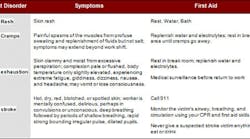The human body is a magnificent cooling machine that transfers heat through conduction, convection, thermal radiation and evaporation in an effort to keep the internal temperature at a comfortable 98.6°F (37°C). However, when the body becomes taxed by high temperature — as is common in metalcasting operations, especially melt shops — these cooling abilities are extremely compromised and put workers at risk of a heat-related illness.
To help protect your employees from the perils of heat injuries it is important to understand how to prevent, spot, and treat heat-related illnesses, and to have in place the proper training and treatment measures.
Preventing heat illness
It is important for metalcasting operators to ensure their operations are taking the proper steps to prevent heat illness in their businesses. Among the steps that employers can take to limit workers’ heat exposure are:
• Scheduling maintenance and repair jobs in hot areas for cooler months.
• Schedule hot jobs for the cooler part of the day.
• Acclimatize workers by exposing them for progressively longer periods to hot work environments.
• Reducing the physical demands of workers.
• Using relief workers or assign extra workers for physically demanding jobs.
• Providing cool water or liquids to workers.
• Providing rest periods with water breaks.
• Providing cool areas for use during break periods.
In addition to the above tips aimed at plant operators, the workers need to take the appropriate steps to protect themselves from heat-related illness. These steps include:
• Wearing light-colored, loose-fitting, breathable clothing such as cotton and avoiding non-breathing synthetic clothing. Gradually building up to heavy work.
• Taking more breaks in extreme heat and humidity.
• Drinking water frequently and to the point they never become thirsty.
• Avoiding drinks with caffeine, alcohol, and large amounts of sugar.
Recognize the warning signs
Heat disorders are preceded by early warning signs. By identifying these physical signs your employees can take appropriate action to prevent heat strain from becoming excessive.
Signs of the unsought of heat-related illness include dizziness, nausea, blurred vision, poor posture, increased heart rate, hand tremors, profuse sweating, sloppy working behaviors, flu-like symptoms and more.
Your employees and supervisors should not only look for these signs in themselves when working, but also look for these signs in their co-workers.
One way to effectively ensure employees are monitoring is the creation of a buddy system. With the buddy system employees are paired off and responsible for monitoring the welfare of one another.
If heat illnesses symptoms are spotted immediately pull the person from the work they are doing, place them in a cool area and hydrate. If the person adequately recovers they may return to work, but try to put them in a less stressing task for the remainder of the day.
Treatment and identification for heat illnesses
When training and prevention measures fail it is important to have in place the knowledge to identify heat illness and properly treat those illnesses.
The nearby graph describes the symptoms and treatment of heat-related illness. It would be a valuable reminder to managers and workers.
Michael Rich is a safety writer and researcher for Safety Services Company, a supplier of safety training materials and compliance products in North America. Learn more at www.safetyservicescompany.com.










